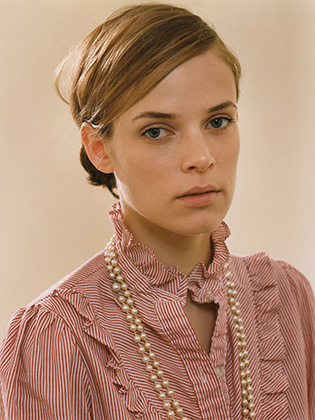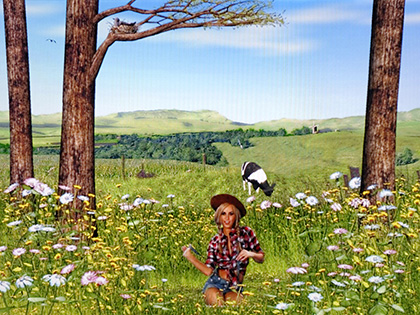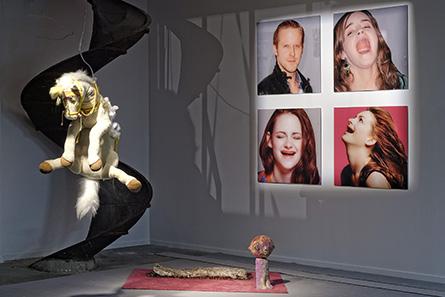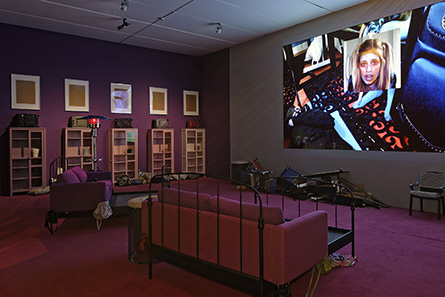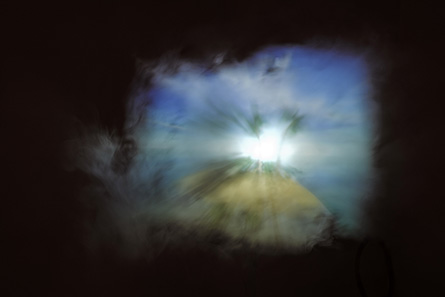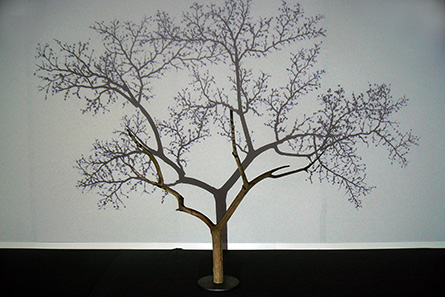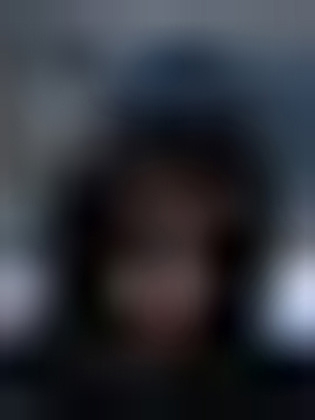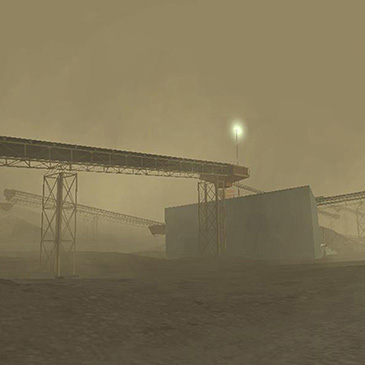LYON BIENNIAL AND THEN
by Dominique Moulon [ November 2013 ]
The Artistic Director of the Lyon Biennial, Thierry Raspail, entrusted the organisation of this twelfth edition to the curator Gunnar B. Kvaran. Extending across multiple sites, such as the MAC, La Sucrerie, and fairs and exhibitions, the Docks Art Fair and the Rendezvous IAC in Villeurbanne also participate in the event.

Art and Identity
Roe Ethridge,
“Nancy”, 2000.
 E
Everywhere in Greater Lyon, we read this narrative promise in capital letters and italics: "MEANWHILE... SUDDENLY, AND THEN." It is accompanied by images; among them is the portrait of “Nancy,” made in 2000 by American-born Roe Ethridge. Everyone recognizes her without knowing her. Everyone tells her story, seeking some clues in the image. New York designer Brendan Dugan created the visual identity of the
Lyon Biennial around the city, even before getting to the museums and art centres, which are challenged with unknown faces. It reminds us of the anonymous person, The Casual Passer-by I met at 3.59 pm, that Braco Dimitrijevic hung on the facade of the Centre Pompidou in 1989 on the occasion of the exhibition Magicians of the Earth. It is precisely this now historic event, which combined non-Western artists with Western artists, conceived by Jean-Hubert Martin, that is, according to a team of researchers from the ZKM Karlshrue, the starting point of a form of globalization of contemporary art. Since the late 80s, biennials have multiplied. For nearly 120 years after the creation of the very first, in Venice, there are now more than a hundred around the world today.centaine dans le monde.

The After Internet
Petra Cortright,
“Vicky Deep
in Spring Valley”,
2013, © Blaise Adilon.
 A
At the entrance to the Sucrière, there are five videos by
Petra Cortright. This young American-born artist belongs to the generation that is referred to as "Digital Native" or "Post-Internet". She is not yet thirty and loves to stage herself in front of her webcam, adding effects to sequences she broadcasts on YouTube, one of her favourite mediums. We understand, looking at her website, that everything she collects online is likely to appear in her work. She appropriates, transforms, and distributes according to the rhythm of her meanderings about the web. At the Sucrière, animated GIFs featuring scantily clad young women performing in sequential movements are set against rural scenery screensavers. It is an artistic practice that might be described as a collision between the elements of a global digital culture. Still on the website, we see her in 2009 eating a hamburger with three-dimensional rabbit ears. In its banality, beyond tracking, the scene is similar to Andy Warhol eating a hamburger. Cortright enters this dialogue, from 1981 – before the emergence of Internet as a medium, changing our perception of the world, as evidenced by seizing the mediums of the time.

New friends
Ed Fornieles,
“Maybe New Friends
(Britney Rivers)”, 2013,
© Blaise Adilon.
 O
On the first floor of the Sucrière,
Ed Fornieles’ installation intrigues us in its strangeness. It includes some clues, objects and images, that fit perfectly in the current “arts & crafts” market trend of the New York art scene. But the title of the work Maybe New Friends (Britney Rivers) provides further guidance. To learn more about this Britney Rivers, one needs simply become her friend on Facebook and follow her on Twitter, because she is one of the seven young actors of the sitcom that takes place entirely on the Internet, the work at the Sucrière being but a gateway in the story that includes us when our friend requests are accepted. We are taken in by the game, investigating the scripted lives of Aaron, Britney, Chuck, Grace, Jesse, Seb, and Vanessa without knowing exactly who is on the other side, accepting the idea that they might very well be conversational agents. The test of artificial intelligence described by the Englishman Alan Turing in 1950 in “Computing machinery and intelligence” would be very useful to us, unless you prefer surrendering yourself to the story in which you become one of the protagonists.

Society of the Spectacle
Lizzie Fitch
& Ryan Trecartin,
“The Re'Search
(Re'Search Wait’S)",
2009-2010,
© Blaise Adilon.
 O
Onto the
MAC Lyon, where the staging in the work of
Lizzie Fitch & Ryan Trecartin is as accurate as it is essential, both in the museum space – through the residential furniture that turns spectators into guests – as well as in the direction of the actors we find within the projected video images. As for the helmets, available to the public, they infer that the experience is decidedly personal. It is by being cut off from the rest of the world that we are witnessing the ordinary spectacle of scripted moments between friends. The sets function like frames, similar to those of reality TV shows – the exteriors and interiors, which are relatively banal, are somewhat at odds with the treatment of the faces by their makeup; like the filtered treatments of the voices which all end up sounding the same. From the comfort of the sofas, to the isolation of the headphones, and on through the audio and video editing whose pace is frenetic, everything is done to retain us a little longer. It is as difficult to pull oneself away from the work of these two American artists as it is impossible to zap the worst moments of a TV that one might blatantly describe as trash. Even the museum context contributes to extending the aesthetic experience when, by the pool (the background necessary for any reality TV show), with nasal voices they call each other bitch!

Once upon a time
Antoine Catala,
“Il était une fois…”, 2013,
© Blaise Adilon.
 S
Some installations at the Museum of Contemporary Art are self explanatory, while others, like that of French-born
Antoine Catala, seem to resist a first reading. One may find themselves needing to look for some clues that might put us on track for a possible story. The artist explains his commitment to the correspondence between objects, images and words on the Biennial website – yet we think of the work One and three chairs (1965) by Kosuth, where a chair object, its photographic image and its textual description are all presented together. It was also in 1965 that Ted Nelson invented the concept of hypertext, which would continue in the form of what was later called hypermedia. We must recognize that the images of objects on the Internet are now also indexed by words. Back to Catala, whose installation in Lyon follows that entitled, I See Catastrophes Ahead (2012), which revolves around a puzzle in English: Icy Cat Ass Trophies a Head. And yet in Lyon, there is the image of an island floating on a cloud of smoke. Is this the promise of the story announced by the legend “Once upon a time...”?

The tree and its shadow
Samuel Rousseau,
“L'arbre et son ombre IV”, 2013, Courtesy galerie Claire Gastaud.
 I
In addition to all these themes, The Lyon Biennial also represents a multitude of meetings, workshops, and exhibitions federated by the Veduta and Resonance programs. Among them, is the
Dock Art Fair artistically directed by Olivier Houg. Its uniqueness lays in the fact that it features solo exhibitions exclusively, including that of the artist
Samuel Rousseau, presented by the
Claire Gastaud Gallery. At the back of the space, the shade of a tree slowly takes shape over the seasons, in accelerated mode – it rapidly branches out, buds emerge, become leaves, and dry only to disappear during their fall. One inevitably thinks of the virtual and interactive tree by Bill Viola, The Tree of Knowledge from 1997. But the tree that Rousseau draws extends the one which dead – a strange relationship develops between the tree and its animated shade, while the inertia of its dead branches leads us inexorably into reality. Everything happens in the invisible layer between The tree and its shadow, our eyes darting back and forth between a few branches of the dead tree, and its infinitely more detailed aura repeating infinitely.

The aesthetics of blurring
Sylvain Couzinet Jacques,
“Outstanding Nominals”, 2012,
Courtesy galerie Un-Spaced.
 T
The solo show at
Un-Spaced is dedicated to
Sylvain Couzinet Jacques, presenting a series of his Outstanding Nominals, photographs that he did not necessarily author, but rather the curate –bringing together enigmatic portraits of rioters that the artist confides is from extracts of images from files of the European police, whose attachment to video surveillance cameras is well known. Like the pixels from the destructive cuts dear to Thomas Ruff, they betray the perfectibility of our security measures, when we will all be identifiable at all times. The fuzziness brings to mind the intimacy and familiarity of Gerhard Richter, and yet at the same time they evoke the distance that separates us from those from we do not want to get close to. The obvious pictorial aspects of Jacques’ portraits fail to hide the imminence of spontaneous demonstrations that are fed by our indifference – from Los Angeles to Athens, through Villiers-le-Bel. It is said that in London, in 2011, the police adopted the use of Flickr in their research, because all of us, in our daily use of the Internet, are potentially informants.

From immersion to wandering
Thibault Brunet,
“Vice-City (12/10/07-22h40)”,
2012,
Courtesy galerie Binôme.
 G
Galerie
Binôme features the photographs of
Thibault Brunet, which are also presented in the exhibition Rendez-vous at the
Institute of Contemporary Art in Villeurbanne. Like many other players of GTA, Brunet refused the missions proposed by the developers of Rockstar North. Instead, as a photographer of the moment, he walked around Vice City to capture scenes of his wanderings. The mists are similar to those of Caspar David Friedrich. The overwhelming feeling of loneliness is that of the scenes depicted by Edward Hopper. Despite this relationship to painting, Brunet’s camera is none other than the engine of the video game in which he has immersed himself. But this practice is resolutely photographic if one considers that photography consists, in particular, of representing one’s immediate environment through images. We can easily imagine Tommy Vercetti getting up early to capture the whiteness of the atmosphere of a city waking up, chasing after faces, in eager expectation of the developing baths that reveal the reality of his morning wanderings. Brunet exhibits a continuation of the history of photography that technologies like these renew, beyond the digitalisation of cameras.

Written by Dominique Moulon for MCD and translated by Geoffrey Finch, November 2013.
